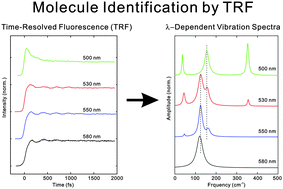Identification of an emitting molecular species by time-resolved fluorescence applied to the excited state dynamics of pigment yellow 101†
Abstract
Time-resolved fluorescence (TRF) with a resolution higher than the periods of vibrations may provide the vibrational spectrum of an emitting species by directly recording the vibrational wave packet motions in time. We applied high-resolution TRF to investigate the excited-state dynamics of pigment yellow 101 (P.Y.101). The TRF spectra of P.Y.101 in dichloromethane showed that upon photoexcitation of the enol isomer, dynamics occur in the S1 state to form a product in two time constants at 30 and 140 fs. TRF signals were modulated due to the vibrational wave packet motions in the excited states, which provided the vibrational spectra of the emitting species. Depending on the emission wavelength, two different vibrational spectra were evident. With the help of theoretical calculations, the two spectra were assigned to the enol and keto isomers of P.Y.101 in the S1 state, leading to the conclusion that P.Y.101 undergoes ultrafast excited-state intramolecular proton transfer (ESIPT) with a quantum yield close to 1. Visible-pump infrared-probe transient absorption spectra were recorded to corroborate this conclusion.


 Please wait while we load your content...
Please wait while we load your content...